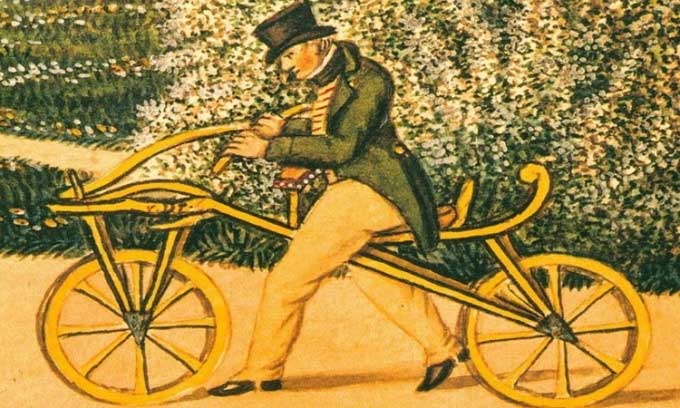The two-wheeled vehicle created by German inventor Karl von Drais caused a sensation in many European countries in the early 19th century.
In April 1815, Mount Tambora on the island of Sumbawa in present-day Indonesia erupted violently, an event unprecedented in history. A colossal amount of debris, estimated at around 10 billion tons, was ejected into the atmosphere. These fragments and ash rose into the stratosphere and spread, covering the sky and obscuring sunlight for many months. The eruption also released a significant amount of sulfur dioxide into the atmosphere, leading to the formation of sulfate aerosols that caused a substantial drop in Earth’s surface temperatures. The cold temperatures and altered weather patterns resulted in crop failures and famine in various parts of the world.

Simulation of Karl von Drais’s two-wheeled vehicle. (Photo: Amusing Planet).
The scarcity of resources profoundly affected daily life, making it difficult for many to sustain traditional transportation animals like horses and donkeys. In this challenging environment, Karl von Drais, a young German inventor, found the motivation to create a new form of transportation that did not rely on horse power. This led to the invention of the world’s first two-wheeled vehicle.
The Laufmaschine, designed by Von Drais, features two wheels aligned like today’s bicycles and motorcycles. The vehicle is made of wood, consisting of a horizontal bar connecting two wooden wheels with spokes. A small leather-covered seat is positioned in the middle of the horizontal bar, providing a place for the rider to sit. A vertical axle with a series of handlebars connects to the front wheel for steering. The propulsion of the vehicle relies entirely on the rider’s strength. The rider sits on the leather seat, pushes their feet down to the ground, and moves back and forth to gain momentum. Each push propels the vehicle further than a walking person.
On June 12, 1817, Von Drais set off from Mannheim along the most beautiful roads to Baden on his Laufmaschine. Traveling southwest, he covered nearly 7 kilometers before reaching an inn named Schwetzinger Relaishaus. Although it is unclear whether Von Drais stopped at the inn to rest, historical records confirm that his round trip took just over an hour, less than half the time it would have taken to walk the same route from Mannheim to the inn and back.
Six months later, Von Drais applied for a patent in France and introduced the term vélocipède to describe his invention. The successful patent application quickly drew attention from French society. Von Drais showcased his pioneering vehicle in several European capitals, captivating large audiences with its innovative design and functionality, while also securing numerous orders for the human-powered vehicle. Since Von Drais handcrafted each component, the delivery time for the vehicles was quite long. Consequently, the initial craze surrounding the vehicle began to wane in Europe later that year. However, recognizing the increasing demand, many manufacturers in France and England sought to capitalize on the popularity of the vélocipède by launching their own versions. Among these, the version produced by seat manufacturer Denis Johnson in London was considered the most practical.
Denis Johnson introduced several improvements to the two-wheeled vehicle he marketed in London. Notably, Johnson’s design featured a downward curve in the horizontal bar, allowing for larger wheels, which enhanced ride quality. Additionally, the iron steering mechanism provided the rider with greater control. At the same time, the integration of iron rims on the outer edges of the wheels significantly increased their durability. Johnson’s version quickly gained popularity in early 1819.
However, the trend of using this vehicle soon faced many obstacles, such as rough road surfaces and frequent encounters with carts, posing challenges in maintaining balance. Some daring individuals even rode on sidewalks, endangering pedestrians. Recognizing the risks associated with this rising trend, authorities in Germany, England, the United States, and even Calcutta restricted cycling areas or outright banned it. By the end of 1819, the craze for the vehicle had nearly subsided. Von Drais continued to invent various other devices, including the first typewriter.


















































